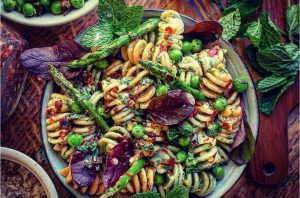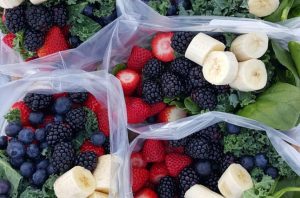
Have you ever downed half a bag of popcorn at the movies before the previews are even over? Or emptied the dish of tortilla chips while waiting for your meal at a restaurant, only to find that you’re already stuffed when your meal finally arrives?
An occasional indulgence is a normal part of life. But if this type of automatic eating becomes a habit, it can take a toll on your health and your happiness.
That’s where mindful eating can be helpful. It’s a strategy that may help you tune into your body’s cues and prevent overeating. It’s not a diet, but rather a practice that can help you slow down, be more aware of what you’re eating and pay attention to whether or not you’re actually hungry.
How does mindful eating work?
“Mindful eating grew out of the concept of mindfulness, which is being aware using all of the senses of the present moment,” explains psychologist Susan Albers, PsyD. “It involves the development of a special kind of awareness that you bring to the table whenever you eat.”
Studies have found mindfulness techniques to be helpful with reducing binge eating and emotional eating. It may also help with weight loss — but that tends to happen slowly over time, Dr. Albers says. Mindful eating isn’t meant to be a quick fix for weight loss.
In fact, for many people, adopting mindful practices is a way to get off the dieting rollercoaster.
There are no menus or recipes for this way of eating, because it’s more about how you eat than what you eat, which makes it less restrictive than fad diets.
It’s about being present in the moment, focusing on what you’re eating and noticing when your body is full.
“This approach builds a healthier relationship with food and gives you a sense of freedom, whereas you may have felt restricted, with a constant feeling that you’re being ‘good’ or ‘bad,’” says Dr. Albers.
Be aware of triggers for mindless eating
The first step to eating more mindfully is becoming aware of what’s triggering your unhealthy eating patterns. Some of the common reasons people overeat include:
* Distraction: How often do you eat dinner in front of the TV, or browse through social media while you’re having lunch? Research shows that people eat more when they’re distracted. “Our bodies just don’t process food in the same way when we’re distracted — and we’re much less in control of how much we’re eating when we’re distracted,” Dr. Albers says.
* Emotions: Boredom, stress and many other emotions can affect your eating patterns — whether they make you ignore your hunger cues or turn to food for comfort. “When patients are struggling with their diet or losing weight, we don’t even talk about their eating until we address their stress level first,” she says.
* Environment: We live in a mindless eating environment, Dr. Albers points out. We’re surrounded by food 24/7. “We can be not even thinking about food and see a commercial and then suddenly we’re craving something,” she says. “We are highly influenced by the people and things around us.”
Practice these mindful eating strategies
Dr. Albers suggests starting with these fundamental behaviors that can help you be more mindful about what, when and how you’re eating.
Sit down while you eat
Eating at your desk, in the car or while you’re making the kids dinner are all prime examples of mindless eating. Turn off the TV and get rid of distractions. “Research indicates that if we sit at a table, that helps us to be mindful of how much we’re eating and enjoy our food more because we’re focused on it,” Dr. Albers says.
Use all your senses
Make an effort to observe the look, smell and mouthfeel of your food. Take small bites. Chew slowly. This is easier said than done and may require practice. “When you’re getting started, set a timer for 20 minutes with a small portion of food and make sure it lasts that long,” Dr. Albers suggests.
Be aware of physical hunger
Pause between each bite of food to ask yourself, “Am I really satisfied? Can I stop here?” “We often eat a whole plate of food before even taking a pause or a breath,” Dr. Albers says. Decipher between being hungry and satisfied to guide your decisions.
Ditch the candy dish
Adjust your environment to make it more conducive to mindful eating. “Take a tour of your house and look around to see what food is out and available,” Dr. Albers says. Are healthy snacks like fruit and nuts the easiest to grab? Or unhealthy snacks like candy and cookies? “In my house, I have a bowl right next to the door that’s filled with healthy snacks like mandarin oranges and nuts. Whenever someone leaves the house, they stop at the bowl, pick something up and put it in their pocket or purse so they don’t have to go to a fast food place or vending machine if they get hungry.”
Evaluate your lifestyle
Other factors — like not getting enough sleep or having high levels of stress in your life — can impact your appetite hormones significantly, Dr. Albers says. “Plus, when we’re tired, we don’t make great decisions around food.”
3 mindful eating exercises
If you catch yourself eating mindlessly, here are a few simple exercises you can try to help you bring your attention back:
1. Go dark. Hunger is strongly affected by visual cues, Dr. Albers says, so try closing your eyes for a second as you take a bite of food. Removing the visual cues can make it less tempting to eat everything on your plate (or in the bag) and easier to focus on what you’re eating and whether you feel full.
2. Take matters into your own hands. A mindful approach means you’re focused on the process of eating and not rushing through a snack or meal. Slow down by using your non-dominant hand to eat. “This will help you become more attentive to the process,” Dr. Albers says.
3. Throw your taste buds a curveball. Does it seem like the first bite of chocolate cake is always the best? There’s a reason for that. “Your taste buds recognize the new sensation and then quickly become used to the taste,” Dr. Albers explains. It can be easy to get caught in a cycle of overeating while unsuccessfully chasing the satisfaction of that first bite. If you’re having trouble walking away from a certain food, try taking a bite of something that’s a different flavor, texture or temperature. Wait a moment, and then go back to the food you’re overeating. Does it taste different? And is that enough to satisfy you?
If you find yourself constantly overeating or unable to control it, there could be an underlying issue involved that needs attention. A therapist, dietitian, nutritionist or physician can help you to get to the bottom of it and work on developing healthier habits.
For premium Slay Fitness artisan supplements CLICK HERE
Source Health Cleveland Clinic







